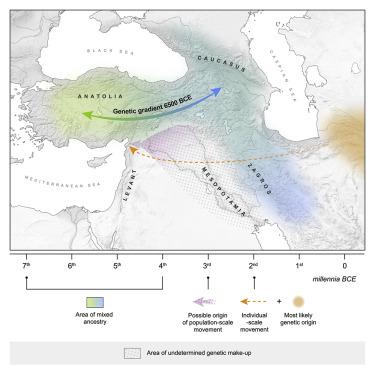Cell ( IF 64.5 ) Pub Date : 2020-05-28 , DOI: 10.1016/j.cell.2020.04.044 Eirini Skourtanioti 1 , Yilmaz S Erdal 2 , Marcella Frangipane 3 , Francesca Balossi Restelli 3 , K Aslıhan Yener 4 , Frances Pinnock 3 , Paolo Matthiae 3 , Rana Özbal 5 , Ulf-Dietrich Schoop 6 , Farhad Guliyev 7 , Tufan Akhundov 7 , Bertille Lyonnet 8 , Emily L Hammer 9 , Selin E Nugent 10 , Marta Burri 1 , Gunnar U Neumann 1 , Sandra Penske 1 , Tara Ingman 5 , Murat Akar 11 , Rula Shafiq 12 , Giulio Palumbi 13 , Stefanie Eisenmann 1 , Marta D'Andrea 3 , Adam B Rohrlach 14 , Christina Warinner 15 , Choongwon Jeong 16 , Philipp W Stockhammer 17 , Wolfgang Haak 1 , Johannes Krause 1

|
Here, we report genome-wide data analyses from 110 ancient Near Eastern individuals spanning the Late Neolithic to Late Bronze Age, a period characterized by intense interregional interactions for the Near East. We find that 6th millennium BCE populations of North/Central Anatolia and the Southern Caucasus shared mixed ancestry on a genetic cline that formed during the Neolithic between Western Anatolia and regions in today’s Southern Caucasus/Zagros. During the Late Chalcolithic and/or the Early Bronze Age, more than half of the Northern Levantine gene pool was replaced, while in the rest of Anatolia and the Southern Caucasus, we document genetic continuity with only transient gene flow. Additionally, we reveal a genetically distinct individual within the Late Bronze Age Northern Levant. Overall, our study uncovers multiple scales of population dynamics through time, from extensive admixture during the Neolithic period to long-distance mobility within the globalized societies of the Late Bronze Age.
Video Abstract
Download : Download video (28MB)
中文翻译:

新石器时代至青铜时代的基因组历史安那托利亚,北黎凡特和南高加索地区。
在这里,我们报告了从新石器时代晚期到青铜时代晚期的110个古代近东个体的全基因组数据分析,该时期的特征是近东地区之间存在强烈的区域间相互作用。我们发现,6日北安纳托利亚中部/北部和南高加索地区的千年BCE种群在新石器时代在西安纳托利亚和今天的南高加索地区/萨格罗斯地区之间形成的遗传系上有着共同的祖先。在晚石器时代和/或青铜时代初期,北部黎凡特基因库的一半以上被替换,而在安纳托利亚其余部分和南部高加索地区,我们记录了仅具有短暂基因流的遗传连续性。此外,我们揭示了北黎凡特晚期青铜时代的遗传个体。总体而言,我们的研究揭示了随着时间推移而变化的多种尺度的人口动态,从新石器时代的广泛混合到晚期青铜时代的全球化社会中的远距离迁移。
录像摘要
下载:下载视频(28MB)



























 京公网安备 11010802027423号
京公网安备 11010802027423号